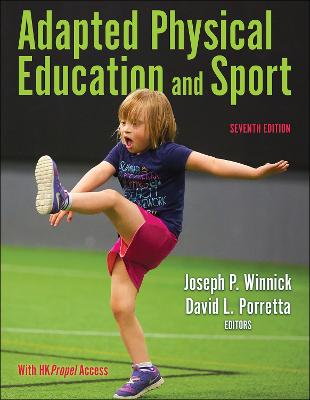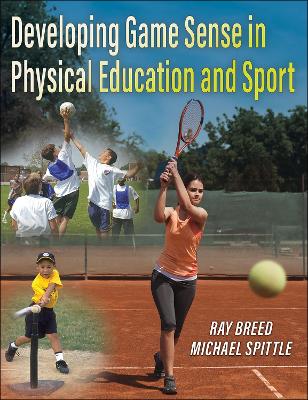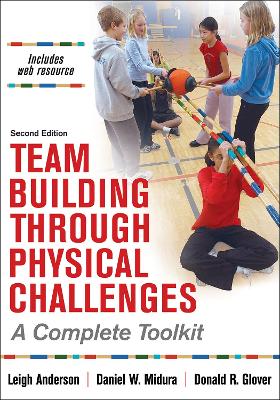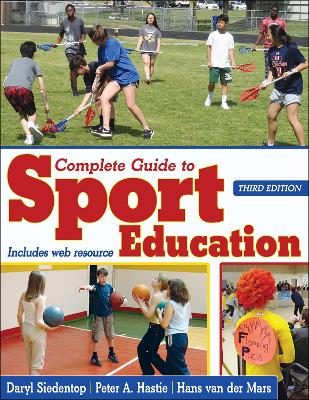Playing Fair
 -15%
portes grátis
-15%
portes grátis
Playing Fair
Butler, Joy I.
Human Kinetics Publishers
07/2016
296
Mole
Inglês
9781450435437
15 a 20 dias
635
Reintegration of Play in Games
Process of Inventing Games
Democracy in Action (DiA)
Worldview of an Inventing Games Teacher: Ecological Complexity Thinking
Summary
Chapter 2 Teaching and Learning Social Justice Through Inventing Games
Revisiting the True Meaning of Competition
Teaching Social Justice and Democracy in Action
Summary
Chapter 3 Scaffolds for Learning: Schema, Transfer, Classifications, and Rules
TGfU Classification and Inventing Games
Understanding Game Constructs Through Inventing Rules
Structuring the Inventing Games Curriculum
Teaching for Transfer
Curriculum Organization
Summary
Chapter 4 Developmental Learning and Curriculum Design
Psychomotor Domain (Moving)
Cognitive Domain (Thinking)
Affective Domain (Feeling)
Conclusions
Summary
Chapter 5 Pedagogical Principles
Joy Butler and Linda L. Griffin
Teaching as Facilitating
Tactical Complexity
Modifications Through Representation, Exaggeration, and Adaptation
Assessment of Learning Outcomes
Summary
Chapter 6 Inventing Unopposed Target Games
Stage 1: Setting the Learning Environment and Setting Conditions for Democracy in Action by Developing a Decision-Making Agreement
Stage 2: Developing Target Game Constructs by Observing a Partner
Stage 3: Inventing and Playing a New Target Game
Stage 4: Refining the Invented Game
Stage 5: Refining the Skills Required in the Invented Game
Stage 6: Challenging Everyone by Adapting Rules
Stage 7: Showcasing the Game
Summary
Chapter 7 Innovative Approaches to Opposed Target Games
James Mandigo
Lesson 1: Accuracy to Target
Lesson 2: Avoiding Obstacles
Lesson 3: Using Obstacles to Get Closer to a Target
Lesson 4: Preventing Scoring (Offense)
Lesson 5: Preventing Scoring (Offense)
Lesson 6: Preventing Scoring (Defense)
Summary
Chapter 8 Inventing Striking Games: Danish Longball
How to Play DLB: Regulations and Rules
Guide for Teaching Stages
Stage 1: Setting the Learning Environment for Democracy in Action and Fair Game Play
Stage 2: Changeover Rule (Transitions)
Stage 3: Refining Rules and Establishing the Role of the Referee
Stage 4: Strategic Offense Concept 1 and Coach and Observer Roles
Stage 5: Strategic Offense Concept 2
Stage 6: Strategic Defense Concept 1
Stage 7: Strategic Defense Concept 2
Stage 8: Showcasing All Games and Standardizing One Through the Democratic Process
Stage 9: Playful DLB Competition Tournament
Summary
Chapter 9 Striking Game: Cricket
Kevin Sandher
Unit Plan Structure
Assessment
Lesson 1: Learning Basic Rules
Lesson 2: Offense Concept: Hitting to Open Space
Lesson 3: Defense Concept: Reducing Batter Time Using Throwing
Lesson 4: Running Between Wickets and Catching to Get Batters Out
Lesson 5: Combination Skills
Lesson 6: Defense Concept-Bowling to Limit the Batter's Time
Lesson 7: Using the GPAI for Assessment
Lesson 8: Pairs Cricket Tournament
Summary
Chapter 10 Inventing Net and Wall Games
Joy Butler and Tim Hopper
Framework (Strategic Concepts and Tactical Decisions)
Stages of Invention and Democracy in Action
Stage 1: Setting the Learning Environment for (A) Democracy in Action and (B) Game Constructs-Defining Net and Wall Games
Stage 2: Spatial Awareness in Net Games-Castle Game
Stage 3: Spatial Awareness in Wall Games
Stage 4: Creating Net and Wall Games Through the Democratic Process
Stage 5: Challenging Everyone Through Adaptation
Stage 6: Refining Games and Establishing the Role of the Coach
Stage 7: Showcasing Games and Revising
Stage 8: Competitive Game
Summary
Chapter 11 Net and Wall Games: Pickleball
Tim Hopper
Game Understanding
Tactical Framework for Strategic Principles
Lessons and Learning Experiences
Court Areas and Learning to Play Pickleball
Area 1: Short-Court Games
Area 2: Long-Court Games
Area 3: Volley-Court Games
Doubles Dink Tennis
Three for a Win
Summary
Chapter 12 Inventing Invasion Games
Stage 1A: Setting the Learning Environment for Invasion Game Constructs and Democracy in Action
Stage 1B: Defining Invasion Game Constructs
Stage 2: Establishing the Game Through the Democratic Process
Stage 3: Playing the Game
Stage 4: Refining the Game
Stage 5: Identifying the Coach
Stage 6: Identifying the Referee
Stage 7: Showcasing Games
Stage 8: Defense
Stage 9: Offense
Stage 10: Transferring Concepts From Inventing Games to Institutionalized Games
Summary
Chapter 13 Invasion Game: Soccer
Steve Mitchell
Lesson 1: Primary and Secondary Rules
Lesson 2: Keeping Possession
Lesson 3: Distribution of Possession
Lesson 4: Penetration and Scoring
Lesson 5: Preventing Scoring
Lesson 6: Denying Space
Lesson 7: Obtaining Possession
Lesson 8: Regaining Possession
Summary
Chapter 14 Invasion Game: Touch Football
Bobby Gibson
Pedagogy
Democracy in Action
Unit Plan Structure
Lesson 1: Ultimate Football
Lesson 2: Flickerball
Lesson 3: Flickerball Extended
Lesson 4: Offensive and Defensive Team Concepts
Lesson 5: Gamelike Situations
Lesson 6: Kicking
Lesson 7: Team Formation and Playbook Design
Lesson 8: Game Play and Game Management
Summary
Chapter 15 Final Thoughts
Reintegration of Play in Games
Process of Inventing Games
Democracy in Action (DiA)
Worldview of an Inventing Games Teacher: Ecological Complexity Thinking
Summary
Chapter 2 Teaching and Learning Social Justice Through Inventing Games
Revisiting the True Meaning of Competition
Teaching Social Justice and Democracy in Action
Summary
Chapter 3 Scaffolds for Learning: Schema, Transfer, Classifications, and Rules
TGfU Classification and Inventing Games
Understanding Game Constructs Through Inventing Rules
Structuring the Inventing Games Curriculum
Teaching for Transfer
Curriculum Organization
Summary
Chapter 4 Developmental Learning and Curriculum Design
Psychomotor Domain (Moving)
Cognitive Domain (Thinking)
Affective Domain (Feeling)
Conclusions
Summary
Chapter 5 Pedagogical Principles
Joy Butler and Linda L. Griffin
Teaching as Facilitating
Tactical Complexity
Modifications Through Representation, Exaggeration, and Adaptation
Assessment of Learning Outcomes
Summary
Chapter 6 Inventing Unopposed Target Games
Stage 1: Setting the Learning Environment and Setting Conditions for Democracy in Action by Developing a Decision-Making Agreement
Stage 2: Developing Target Game Constructs by Observing a Partner
Stage 3: Inventing and Playing a New Target Game
Stage 4: Refining the Invented Game
Stage 5: Refining the Skills Required in the Invented Game
Stage 6: Challenging Everyone by Adapting Rules
Stage 7: Showcasing the Game
Summary
Chapter 7 Innovative Approaches to Opposed Target Games
James Mandigo
Lesson 1: Accuracy to Target
Lesson 2: Avoiding Obstacles
Lesson 3: Using Obstacles to Get Closer to a Target
Lesson 4: Preventing Scoring (Offense)
Lesson 5: Preventing Scoring (Offense)
Lesson 6: Preventing Scoring (Defense)
Summary
Chapter 8 Inventing Striking Games: Danish Longball
How to Play DLB: Regulations and Rules
Guide for Teaching Stages
Stage 1: Setting the Learning Environment for Democracy in Action and Fair Game Play
Stage 2: Changeover Rule (Transitions)
Stage 3: Refining Rules and Establishing the Role of the Referee
Stage 4: Strategic Offense Concept 1 and Coach and Observer Roles
Stage 5: Strategic Offense Concept 2
Stage 6: Strategic Defense Concept 1
Stage 7: Strategic Defense Concept 2
Stage 8: Showcasing All Games and Standardizing One Through the Democratic Process
Stage 9: Playful DLB Competition Tournament
Summary
Chapter 9 Striking Game: Cricket
Kevin Sandher
Unit Plan Structure
Assessment
Lesson 1: Learning Basic Rules
Lesson 2: Offense Concept: Hitting to Open Space
Lesson 3: Defense Concept: Reducing Batter Time Using Throwing
Lesson 4: Running Between Wickets and Catching to Get Batters Out
Lesson 5: Combination Skills
Lesson 6: Defense Concept-Bowling to Limit the Batter's Time
Lesson 7: Using the GPAI for Assessment
Lesson 8: Pairs Cricket Tournament
Summary
Chapter 10 Inventing Net and Wall Games
Joy Butler and Tim Hopper
Framework (Strategic Concepts and Tactical Decisions)
Stages of Invention and Democracy in Action
Stage 1: Setting the Learning Environment for (A) Democracy in Action and (B) Game Constructs-Defining Net and Wall Games
Stage 2: Spatial Awareness in Net Games-Castle Game
Stage 3: Spatial Awareness in Wall Games
Stage 4: Creating Net and Wall Games Through the Democratic Process
Stage 5: Challenging Everyone Through Adaptation
Stage 6: Refining Games and Establishing the Role of the Coach
Stage 7: Showcasing Games and Revising
Stage 8: Competitive Game
Summary
Chapter 11 Net and Wall Games: Pickleball
Tim Hopper
Game Understanding
Tactical Framework for Strategic Principles
Lessons and Learning Experiences
Court Areas and Learning to Play Pickleball
Area 1: Short-Court Games
Area 2: Long-Court Games
Area 3: Volley-Court Games
Doubles Dink Tennis
Three for a Win
Summary
Chapter 12 Inventing Invasion Games
Stage 1A: Setting the Learning Environment for Invasion Game Constructs and Democracy in Action
Stage 1B: Defining Invasion Game Constructs
Stage 2: Establishing the Game Through the Democratic Process
Stage 3: Playing the Game
Stage 4: Refining the Game
Stage 5: Identifying the Coach
Stage 6: Identifying the Referee
Stage 7: Showcasing Games
Stage 8: Defense
Stage 9: Offense
Stage 10: Transferring Concepts From Inventing Games to Institutionalized Games
Summary
Chapter 13 Invasion Game: Soccer
Steve Mitchell
Lesson 1: Primary and Secondary Rules
Lesson 2: Keeping Possession
Lesson 3: Distribution of Possession
Lesson 4: Penetration and Scoring
Lesson 5: Preventing Scoring
Lesson 6: Denying Space
Lesson 7: Obtaining Possession
Lesson 8: Regaining Possession
Summary
Chapter 14 Invasion Game: Touch Football
Bobby Gibson
Pedagogy
Democracy in Action
Unit Plan Structure
Lesson 1: Ultimate Football
Lesson 2: Flickerball
Lesson 3: Flickerball Extended
Lesson 4: Offensive and Defensive Team Concepts
Lesson 5: Gamelike Situations
Lesson 6: Kicking
Lesson 7: Team Formation and Playbook Design
Lesson 8: Game Play and Game Management
Summary
Chapter 15 Final Thoughts











